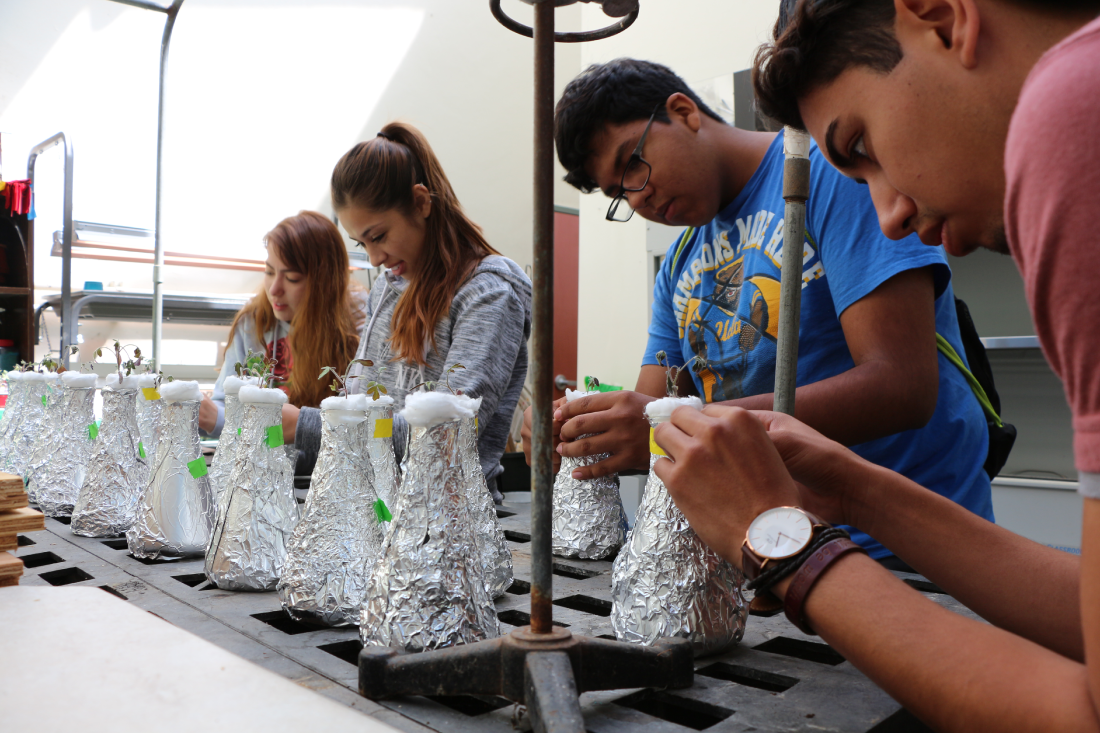Student Research Showcase
by Jan Janes on Sep 9, 2016What did you do on your summer vacation?
STEM (science, technology, engineering and math) summer interns gathered on a breezy August morning in Gavilan College's Science Quad to present their experiments at the annual science symposium.
For the 19 students, the event capped 12 weeks of intensive work. Many were enrolled in summer classes as well. For Gavilan College instructors, the program culminated eight years supporting organized research and collaboration.

STEM summer intern students pause in the Science Quad after presenting their projects to mentors and instructors. Gavilan College Trustee Lois Locci (left), and President Kathleen Rose (third from right), acknowledged the work of retiring math instructor Hope Jukl (center, in white sweater) for her stewardship in building and managing the program for eight years.
"Completion of the program is transformative," said Rey Morales, Gavilan biology instructor and program leader for the STEM program. "In the short time students had with their mentors and peers, their understanding of the field grew."
Projects ranged from the study of endophytes to cancer research and water biomes. Students joined research teams working in labs and on projects at San Jose State University, Elkhorn Slough, NASA, Pinnacles National Park, Cañada de Los Osos and on Gavilan's Gilroy campus.
Walking through the various presentations, Dr. Kathleen Rose, newly appointed Gavilan College president and superintendent said, "I learned a whole new vocabulary by speaking to the students today."
Past institutional partners included UC Davis, Cal State East Bay, CSUMB and New Mexico State University. The collaboration brings lifelong benefits to students.
"Roughly 90% of the participants continued to study in the field where they were placed," said Morales. "And 25% found immediate work in a university lab once they transferred, because of the skills and networking gained during the Gavilan STEM internship program."
Documentation and presentation, key science skills
Students presented their work August 19, the final day of the program. Oversize posters documented their hypotheses, prior research, experiments conducted during the summer, along with the results.
"Over the past eight years we have had a 100% completion rate," noted Morales.

Fran Lozano, Dean of Liberal Arts & Sciences, listens as Jeziel Lopez describes his STEM internship project. He placed motion-activated, night-light sensitive cameras in remote areas on campus to capture images and document wildlife at Gavilan College, then built a website illustrating the results.
In previous years, students have traveled to other cities and states to present their work, including at the Society for the Advancement of Chicanos and Native Americans in Science national conferences. This October the STEM interns will attend a national science and math conference in Long Beach.
STEM summer internships allow students to attract mentors, study in nationally known research labs and expand their academic and professional networks. Collaborative partners, local businesses and organizations all have hired Gavilan STEM interns at the end of each program term.
Fulfilling one aspect of the program, interns reported weekly progress using a members-only Google Plus website. Some students recorded positive results each week, while others documented disappointing research outcomes, the need to adjust hypotheses or to change overall project scope.
Gavilan campus: a living laboratory
"Students described ways the college can make the campus more inviting and sustainable for native wildlife," said Morales. "Projects that share the botanical richness of the campus by showcasing it on an interactive website are exciting."
STEM students explored various campus features that offer the grounds as a living laboratory. Combining science and technology, one student installed motion sensitive cameras on animal trails, downloaded photographs and built a campus wildlife website.
One intern researched water biomes using the upper pond. Another student managed a floating island research project in the lower pond. Other students erected bird houses to document avian populations and installed pitfalls for insect and small reptile collection.

With assistance from Dr. John Freeman (left), Director of Science at NASA and STEM mentor, intern Alex Ramirez pulled the capsized floating island to shore at the lower pond on the Gilroy campus. The willow planted on the floating island grew too tall and top heavy, dragging the experimental biomediation installation onto its side. After pruning, the island was guided back to the pond's center.
A look back and a plan forward
Funding for Gavilan College's STEM internship program, which began in the summer of 2009 with a federal grant, is now at the end of its cycle.
"The college does have another grant application in, but we haven't heard yet," according to Hope Jukl, retiring math instructor and STEM administrator. "Right now we have a one-year, no-cost extension of the original grant."
Jukl also served as the coordinator of Science Alive, a program that attracts scores of middle school students to Gavilan College each year. Many of the 2016 STEM summer interns attended Science Alive in their youth.

STEM summer interns (l-r) Cindy Togliatti, Andrea Alvarez, Jeziel Lopez and Miguel Lopez examine tomato seedling growth two weeks after soaking their roots in several different chemical formulas.
To help build a stronger program, local organizations, businesses and individuals could sponsor a STEM student for the summer. Professionals in the fields of science, math, engineering and technology are invited to mentor Gavilan students to translate classroom teaching to real applications. Gavilan Natural Sciences faculty are committed to securing monies for the program.
After reviewing the student work and talking with the instructors and mentors, Dr. Rose said, "Please pass the word that STEM is alive, well and thriving here at Gavilan."
